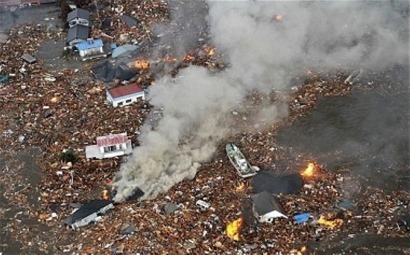
Kyoto News is reporting that as many as 88,000 people are missing.
As the tragedy wore on, wide spread coastal damage was reported after a 12 metre tsunami smashed into the coastline, swamping cities, towns and farms, some of which the government hoped would be pressed into service for bio-fuel production.
Tsunami warnings are now up for the entire Pacific rim, with emergency preparations occurring as far away from the epicentre of the quake as Mexico, South America, the Pacific Northwest in the US and British Columbia in Canada.
The earthquake struck at 2.46 p.m. local time, and in the hours that followed, there were at least 24 major aftershocks of at least 5.4 magnitude.
The Japanese utility Hokuriku Electric Co. said that all three of its nuclear reactors at its Onagawa plant in northern Japan had shut down automatically, as did a nuclear plant in the Fukushima 1 prefecture operated by Tokyo Electric Power (Tepco).
Tepco reported the plant was shut down after at least one diesel generator used to cool its reactors, failed. Japan’s Chief cabinet Secretary Yukio Edano said that at no leak has occurred and safety has not been compromised at the facility.
However, the situation is apparently worse at the Tohoju Eletric Power Co.’s Onagawa facility, where officials said the process of cooling the reactor is “not going as planned” and a “nuclear emergency situation” has been declared.
In addition, there are several reports that a Cosmo Oil refinery was burning outside of Tokyo.
As night fell in Japan, Tepco reported at least 4.5 million around Tokyo were without power, and that many northern districts in the country are entirely without power.
Officials had been looking at the nation’s northern prefectures as a potential clean-power solution to Tokyo’s voracious and growing energy needs. The region is seen as critical to helping Tokyo achieve its goal of reducing its greenhouse gas emission 20 percent below 2000 levels by 2020.
Tokyo’s density limits the installation of local renewable energy sources, but the five energy-supply prefectures – Hokkaido, Aomori, Iwate, Akita and Yamagata, are all considered to have abundant sources of natural energy.
A recent report said that Japan’s greatest potential for developing wind power lies in Hokkaido, and the coastline struck by the tsunami this morning has been considered prime for the potential public-private development of wave-power electricity.
For additional information
Tokyo Metropolitan Government plan to enhance renewable energy

